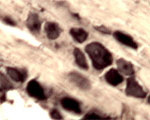Amyloid-beta precursor protein (APP), Rabbit Polyclonal Antibody
As low as
US$317.00
Only %1 left
Catalog Number
R-071
- Product Name Amyloid-beta precursor protein (APP), Rabbit Polyclonal Antibody
- Product Description Rabbit anti-Amyloid-beta precursor protein (APP) Polyclonal Antibody (Unconjugated), suitable for IHC-Frozen.
- Alternative Names Amyloid beta A4 protein; ABPP; Alzheimer disease amyloid protein homolog; Amyloidogenic glycoprotein; AG
- Application(s) IHC-Frozen
- Antibody Host Rabbit
- Antibody Type Polyclonal
- Specificity Specificity for APP was confirmed by IHC. This antiserum is known to react with rat APP. Reactivity with other species have not yet been tested.
- Species Reactivity Mouse, Rat
- Immunogen Description A synthetic peptide (HMNVQNGKWESDPSGTKTC, aa: 44-62) as part of mouse APP isoform A conjugated to the immunogenic protein Blue Carrier Protein
- Conjugate Unconjugated
- Purity Description Whole serum
- Regulatory Status For research use only.
Product Info
- Product Description Rabbit anti-Amyloid-beta precursor protein (APP) Polyclonal Antibody (Unconjugated), suitable for IHC-Frozen.
- Application(s) IHC-Frozen
- Application Details IHC. Recommended to be used at a dilution of 1:500 to 1:3000 for immunohistochemistry. This antiserum has not yet been tested for western blot. Biosensis recommends optimal dilutions/concentrations should be determined by the end user.
- Target Amyloid-beta precursor protein (APP)
- Specificity Specificity for APP was confirmed by IHC. This antiserum is known to react with rat APP. Reactivity with other species have not yet been tested.
- Target Host Species Mouse
- Species Reactivity Mouse, Rat
- Antibody Host Rabbit
- Antibody Type Polyclonal
- Antibody Isotype Mixed
- Conjugate Unconjugated
- Immunogen Description A synthetic peptide (HMNVQNGKWESDPSGTKTC, aa: 44-62) as part of mouse APP isoform A conjugated to the immunogenic protein Blue Carrier Protein
- Purity Description Whole serum
- Format Lyophilized
- Reconstitution Instructions Spin vial briefly before opening. Reconstitute in 100 µL sterile-filtered, ultrapure water. Centrifuge to remove any insoluble material.
- Storage Instructions After reconstitution keep aliquots at -20°C for a higher stability, and at 2-8°C with an appropriate antibacterial agent. Glycerol (1:1) may be added for an additional stability. Avoid repetitive freeze/thaw cycles.
- Batch Number Please see item label.
- Expiration Date 12 months after date of receipt (unopened vial).
- Alternative Names Amyloid beta A4 protein; ABPP; Alzheimer disease amyloid protein homolog; Amyloidogenic glycoprotein; AG
- Uniprot Number P12023
- Uniprot Number/Name P12023 (A4_MOUSE)
- Scientific Background FUNCTION: Functions as a cell surface receptor and performs physiological functions on the surface of neurons relevant to neurite growth, neuronal adhesion and axonogenesis. Involved in cell mobility and transcription regulation through protein-protein interactions. Can promote transcription activation through binding to APBB1/Tip60 and inhibit Notch signaling through interaction with Numb. Couples to apoptosis-inducing pathways such as those mediated by G(O) and JIP. Inhibits G(o) alpha ATPase activity. Acts as a kinesin I membrane receptor, mediating the axonal transport of beta-secretase and presenilin 1. May be involved in copper homeostasis/oxidative stress through copper ion reduction. Can regulate neurite outgrowth through binding to components of the extracellular matrix such as heparin and collagen I and IV. FUNCTION: Beta-amyloid peptides are lipophilic metal chelators with metal-reducing activity. Bind transient metals such as copper, zinc and iron. Rat and mouse beta-amyloid peptides bind only weakly transient metals and have little reducing activity due to substitutions of transient metal chelating residues. Beta-APP42 may activate mononuclear phagocytes in the brain and elicit inflammatory responses. Promotes both tau aggregation and TPK II-mediated phosphorylation (By similarity). FUNCTION: The gamma-CTF peptides as well as the caspase-cleaved peptides, including C31, are potent enhancers of neuronal apoptosis. SUBUNIT: Binds, via its C-terminus, to the PID domain of several cytoplasmic proteins, including APBB family members, the APBA family, MAPK8IP1, SHC1, Numb and Dab1. Binding to Dab1 inhibits its serine phosphorylation. Also interacts with GPCR-like protein BPP, FPRL1, APPBP1, IB1, KNS2 (via its TPR domains), APPBP2 (via BaSS) and DDB1. In vitro, it binds MAPT via the MT-binding domains. Associates with microtubules in the presence of ATP and in a kinesin-dependent manner. Interacts, through a C-terminal domain, with GNAO1. Amyloid beta-42 binds CHRNA7 in hippocampal neurons. Beta-amyloid associates with HADH2. TISSUE SPECIFICITY: different isoforms in different tissues: kidney. brain. liver. hippocampus, substania nigra pars compacta and cerebellum. In the cerebellum, all the isoforms are abundantly expressed in Purkinje cells.
- Shipping Temperature 25°C (ambient)
- UNSPSC CODE 41116161
- Regulatory Status For research use only.
Specifications
-
General References
Wilson, C.A., et al., J. Neurosci. Res. 74: 361-369 (2003).
Andreasen, N., et al., World J. Biol. Psychiatry 4: 147-155 (2003).
Guenette, S.Y. Neuromolecular Med. 4: 147-160 (2003).

 1800 605-5127
1800 605-5127 +61 (0)8 8352 7711
+61 (0)8 8352 7711

